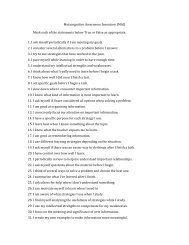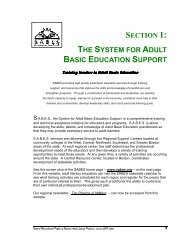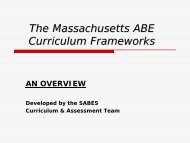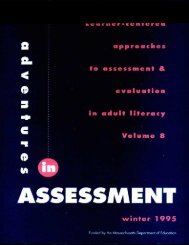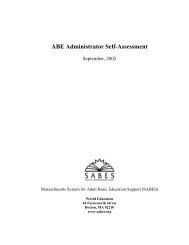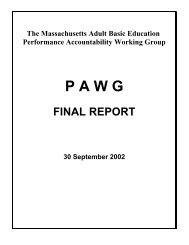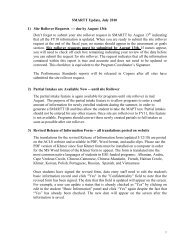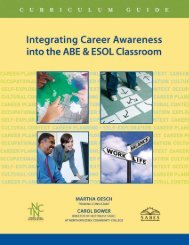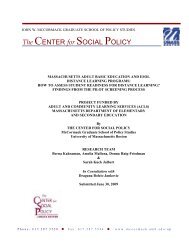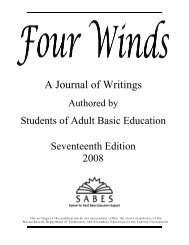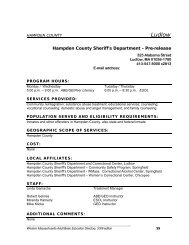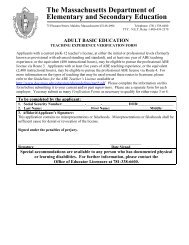Running Effective Meetings and Facilitating Groups - SABES
Running Effective Meetings and Facilitating Groups - SABES
Running Effective Meetings and Facilitating Groups - SABES
Create successful ePaper yourself
Turn your PDF publications into a flip-book with our unique Google optimized e-Paper software.
<strong>Running</strong> <strong>Effective</strong> <strong>Meetings</strong> <br />
&<br />
<strong>Facilitating</strong> <strong>Groups</strong><br />
Revised, July 2002<br />
A guide developed by<br />
Northeast <strong>SABES</strong>, 45 Franklin Street, Lawrence, MA 01840<br />
Telephone: 978-738-7301 Fax: 978-738-7115
Contents<br />
I. Starting the Meeting<br />
Introduction Exercises<br />
Sign-in Sheet<br />
4<br />
5<br />
II.<br />
III.<br />
IV.<br />
Getting Organized<br />
Agenda<br />
Chairperson<br />
Time Keeper<br />
Note Taker<br />
Meeting Organizer<br />
Setting Ground Rules<br />
Simulation of Difficult Meeting<br />
Ground Rules<br />
Learning Community Behaviors<br />
Issues Bin<br />
Break Time<br />
<strong>Facilitating</strong><br />
Thoughts <strong>and</strong> Tips for Facilitators<br />
Active Listening<br />
Brainstorming<br />
Rotating Newsprint<br />
Dot Voting / Spend a Dollar<br />
Snowball/Consensus- Making Activity<br />
Affinity Diagram<br />
Interrelationship Digraph<br />
Force Field Analysis<br />
7<br />
8<br />
9<br />
9<br />
10<br />
12<br />
13<br />
13<br />
14<br />
15<br />
17<br />
18<br />
19<br />
20<br />
21<br />
22<br />
23<br />
24<br />
25<br />
V. Closing the Meeting<br />
Renegotiating Time/Agenda<br />
Next Steps or Action Planning<br />
Evaluation Techniques<br />
27<br />
27<br />
28<br />
<strong>Running</strong> <strong>Effective</strong> <strong>Meetings</strong> <strong>and</strong> <strong>Facilitating</strong> <strong>Groups</strong>, Northeast <strong>SABES</strong>, July 2002
Starting the Meeting<br />
<strong>Running</strong> <strong>Effective</strong> <strong>Meetings</strong> <strong>and</strong> <strong>Facilitating</strong> <strong>Groups</strong>, Northeast <strong>SABES</strong>, July 2002<br />
3
INTRODUCTION EXERCISES<br />
It is essential for meetings to start with some type of Introduction Exercise or Icebreaker. When you<br />
have a large group, or you have a very full agenda, it may seem like a waste of time to conduct personal<br />
introductions. But we have found that introductions are crucial to the overall comfort, trust, <strong>and</strong> risk-taking<br />
ability of the group.<br />
Introductions provide a way for group members:<br />
• to get to know each other,<br />
• to gain a deeper appreciation of each other as individuals, <strong>and</strong><br />
• to underst<strong>and</strong> the mindset of different group members on the meeting day.<br />
If you are dealing with a particularly large group <strong>and</strong> personal introductions will take too much time,<br />
you may wish to have the group sit at small tables where introductions can take place among 4-8 people. At<br />
the very least, provide time for people to introduce themselves to the one or two people sitting next to them.<br />
Some examples of Introduction Exercises or Icebreakers are:<br />
1. Make nameplates <strong>and</strong> introduce yourself with your nameplate. Be sure to have group members write their<br />
name on both the front <strong>and</strong> the back of the nameplates. This enables people sitting next to, as well as across<br />
from, each other to read the nameplates.<br />
2. Take turns saying your name <strong>and</strong> then, saying or acting out something you like to do while the group repeats<br />
your name <strong>and</strong> mimics your acting. This example is useful as a round-robin memory exercise.<br />
3. Meet the person next to you <strong>and</strong> let them introduce you to everyone else.<br />
4. Take something out of your wallet, pocket, or bag <strong>and</strong> tell everyone why it is important to you.<br />
5. Have each person in the group identify themselves with a musical instrument, cartoon character, animal, etc.<br />
(choose one) <strong>and</strong> explain why. Then ask them to guess what musical instrument, etc. their colleagues <strong>and</strong>/or<br />
friends might have identified <strong>and</strong> explain.<br />
6. Ask people to identify themselves <strong>and</strong> then tell what they had for breakfast that morning.<br />
7. Ask people to identify themselves <strong>and</strong> then talk about what their commute to the meeting was like that day.<br />
<strong>Running</strong> <strong>Effective</strong> <strong>Meetings</strong> <strong>and</strong> <strong>Facilitating</strong> <strong>Groups</strong>, Northeast <strong>SABES</strong>, July 2002<br />
4
SIGN-IN SHEET<br />
A Sign-in Sheet is a way to take attendance <strong>and</strong> have evidence of who was at a meeting. Sometimes you may only need<br />
signatures. Other times, you might want the meeting participants to give more information, such as mailing address, telephone<br />
number, e-mail address, <strong>and</strong> fax number. E-mail is especially efficient when you want to send a quick memo, the minutes of<br />
the meeting, or information pertinent to a group of people.<br />
Participants often underestimate the value of the Sign-In Sheet <strong>and</strong> therefore write quickly <strong>and</strong> often messily. If you<br />
want to refer to the Sign-In Sheet for phone numbers <strong>and</strong> addresses, be sure to stress to them to write legibly.<br />
Below is a simple sample of a Sign-In Sheet.<br />
SAMPLE:<br />
NAME PROGRAM / ADDRESS TELEPHONE # EMAIL<br />
Marcia Drew Hohn Northeast <strong>SABES</strong><br />
45 Franklin Street<br />
Lawrence, MA 01840<br />
978-738-7301 Mdrewhohn@aol.com<br />
Alisa Vlahakis<br />
Northeast <strong>SABES</strong><br />
45 Franklin Street<br />
Lawrence, MA 01840<br />
978-738-7304 Avlahakis@aol.com<br />
<strong>Running</strong> <strong>Effective</strong> <strong>Meetings</strong> <strong>and</strong> <strong>Facilitating</strong> <strong>Groups</strong>, Northeast <strong>SABES</strong>, July 2002<br />
5
Getting Organized<br />
<strong>Running</strong> <strong>Effective</strong> <strong>Meetings</strong> <strong>and</strong> <strong>Facilitating</strong> <strong>Groups</strong>, Northeast <strong>SABES</strong>, July 2002<br />
6
AGENDA<br />
It is very important to have an agenda (a list of things that the group needs <strong>and</strong> wants to talk about). It is a way to make<br />
sure that all the necessary discussion takes place <strong>and</strong> to keep the meeting “on track”.<br />
The agenda is usually set before the meeting--most often by the person who will lead the meeting (the chairperson).<br />
Sometimes the agenda items are decided at a previous meeting <strong>and</strong> sometimes the chairperson sets the agenda by conferring<br />
with other group members outside of meetings. The agenda should be typed <strong>and</strong> copies made for everyone in the group. It<br />
helps meetings run more smoothly if the agenda is posted in a conspicuous place. Then, group members know what will be<br />
discussed <strong>and</strong> can prepare for the discussion.<br />
An agenda can be changed during the meeting. Sometimes new items to discuss are added or the order of discussion is<br />
changed. Sometimes agenda items are deleted if the group decides they do not need to talk about a particular item or the<br />
discussion is deferred to another meeting. The chairperson of the meeting should ask group members if they have additions or<br />
changes to the agenda at the beginning of the meeting.<br />
It is a good idea to have times assigned to each agenda item so you will know approximately how much time the<br />
meeting will take.<br />
A SAMPLE AGENDA OF A 1.5 HOUR MEETING WITH TIMES ASSIGNED FOR EACH AGENDA ITEM:<br />
Introduction of new members 10:00 - 10:10<br />
Additions/changes to the agenda 10:10 - 10:15<br />
Review of information <strong>and</strong>/or minutes from last meeting 10:15 - 10:25<br />
Reports on progress by group members 10:25 - 11:00<br />
New business 11:00 - 11:20<br />
Tom’s request to buy books, Irina’s proposal for a field trip<br />
Other business 11:20 - 11:30<br />
Another agenda format that is useful is to have individual group members responsible for facilitating each agenda item<br />
<strong>and</strong>/or a designated outcome needed, using a grid with columns. For example:<br />
ITEM TIME PERSONS RESPONSIBLE OUTCOME NEEDED<br />
<strong>Running</strong> <strong>Effective</strong> <strong>Meetings</strong> <strong>and</strong> <strong>Facilitating</strong> <strong>Groups</strong>, Northeast <strong>SABES</strong>, July 2002<br />
7
HOW TO CHOOSE THE CHAIRPERSON<br />
Sometimes someone becomes the chairperson because of his/her position in the group. For example, s/he is the director<br />
or the supervisor of others in the group. Sometimes the group elects the chairperson to serve in that role for a particular period<br />
of time (six months, a year, etc.).<br />
In groups where there is a lot of shared responsibility <strong>and</strong> shared leadership, rotating the duties of chairperson works<br />
well. In this case, each person takes a turn at being the chairperson. This can be done alphabetically so that the person whose<br />
last name begins with “A”, or the closest to “A”, goes first <strong>and</strong> then down the list of group members alphabetically, starting<br />
over when you have reached the last person. In this way, all the group members gain experience in chairing meetings <strong>and</strong> the<br />
work of being a chairperson (which is considerable) gets shared.<br />
ROLE OF THE CHAIRPERSON<br />
The chairperson is important because s/he takes the responsibility for many tasks that keep a meeting running smoothly.<br />
It is the responsibility of the chairperson to:<br />
◊<br />
◊<br />
◊<br />
◊<br />
◊<br />
arrange for the room <strong>and</strong> refreshments;<br />
set the agenda <strong>and</strong> type <strong>and</strong> distribute it (preferably prior to the meeting);<br />
start the meeting on time;<br />
lead the meeting, making sure the group stays on the agenda item under discussion, <strong>and</strong> keeps within the time set for<br />
that item; <strong>and</strong><br />
end the meeting on time.<br />
<strong>Running</strong> <strong>Effective</strong> <strong>Meetings</strong> <strong>and</strong> <strong>Facilitating</strong> <strong>Groups</strong>, Northeast <strong>SABES</strong>, July 2002<br />
8
TIMEKEEPER<br />
The role of the timekeeper is to keep track of the time during the meeting. Usually a group<br />
has a lot of items of the agenda to cover during the meeting. Very often, it takes longer than<br />
expected to discuss/decide about those items. The timekeeper helps keep the group “on track” by<br />
telling them if they have run over the allotted time for an item (if a specific time has been set) <strong>and</strong><br />
/or how the group is progressing on time overall. For example, suppose there are ten items to<br />
discuss on the agenda in a two-hour meeting. After one hour only two items have been addressed.<br />
The timekeeper would then bring the group’s attention to this fact so the group could decide<br />
whether to defer items, speed up discussion or take another tack. Sometimes the chairperson<br />
functions as a timekeeper but often there is a separate timekeeper at meetings.<br />
NOTE-TAKER<br />
The note-taker records the important comments <strong>and</strong> decisions that the group makes<br />
during the meeting. These notes are called the “minutes” of the meeting.<br />
Notes may be h<strong>and</strong>written discretely while the meeting is conducted. However, many<br />
groups, business, <strong>and</strong> organizations (Northeast <strong>SABES</strong> included) take notes on large newsprint<br />
with colored markers so that the notes will be visible to everyone throughout the meeting.<br />
The visibility of the notes allows an agreed-upon collective perception to be recorded.<br />
Members of the group can repeat or reword statements for the note-taker so that they are sure<br />
what they have said is written in the manner they wish. This helps to avoid misunderst<strong>and</strong>ings<br />
later. Large newsprint notes also provide a h<strong>and</strong>y reference to what was said <strong>and</strong> can be useful<br />
in planning processes.<br />
Note-takers often have the notes typed after the meeting for duplication. However, if the<br />
notes are taken in neat, legible h<strong>and</strong>writing, they can be duplicated as is. Increasingly, note-takers<br />
are using a laptop computer in order to save time. Laptop notes are easily sent via e-mail or<br />
printed out directly, without the additional step of typing h<strong>and</strong>written notes into the computer.<br />
Any way that works best for the group is fine.<br />
Finally, it is important for the minutes (the meeting notes) to be distributed to the<br />
members of the group. This can be done at the next meeting. However, if possible, it is better to<br />
distribute the minutes with the upcoming agenda before the next meeting.<br />
<strong>Running</strong> <strong>Effective</strong> <strong>Meetings</strong> <strong>and</strong> <strong>Facilitating</strong> <strong>Groups</strong>, Northeast <strong>SABES</strong>, July 2002<br />
9
MEETING ORGANIZER<br />
For a group to function effectively, it is important to know in advance how you will operate. Some important<br />
considerations for meetings are:<br />
TIME:<br />
PLACE:<br />
TOPICS:<br />
CHAIR:<br />
FOOD:<br />
MINUTES:<br />
ATTENDANCE:<br />
MEMBER LIST:<br />
On what day <strong>and</strong> at what time will you meet? Is this a convenient time for all involved in the meeting?<br />
Where will you meet? Do people need directions to the meeting place? How do you want to set up your<br />
space? (Sometimes you don’t have a choice <strong>and</strong> a room can only be set up one way.) Do you want<br />
people to sit in small groups? Or around a big table?<br />
What is your agenda?<br />
Who will print up the agenda <strong>and</strong> run the meeting?<br />
Will there be snacks? Who will bring them?<br />
Who will take <strong>and</strong> distribute notes from the meeting?<br />
What if it snows? Who do you call if you can’t come?<br />
Who are the members of the group <strong>and</strong> how do you contact each other?<br />
<strong>Running</strong> <strong>Effective</strong> <strong>Meetings</strong> <strong>and</strong> <strong>Facilitating</strong> <strong>Groups</strong>, Northeast <strong>SABES</strong>, July 2002<br />
10
Setting Ground Rules<br />
<strong>Running</strong> <strong>Effective</strong> <strong>Meetings</strong> <strong>and</strong> <strong>Facilitating</strong> <strong>Groups</strong>, Northeast <strong>SABES</strong>, July 2002<br />
11
SIMULATION OF A DIFFICULT MEETING<br />
GROUP MEMBER<br />
The INTERRUPTER<br />
The BIRDWALKER<br />
The KNITTER<br />
KRAMER<br />
The SIDE-TALKER<br />
The DO-ER<br />
The CHAIR<br />
The OBSERVER<br />
ROLE<br />
Your role is to constantly interrupt people when they are talking. You never let anyone<br />
finish what he or she is saying. To do this you may have to speak loudly <strong>and</strong> be rude.<br />
Your role is to go off track by changing the subject or by talking about something that<br />
isn’t relevant to the discussion or meeting topic.<br />
Your role is to NOT pay attention. This means you are doing something distracting while<br />
other people are talking. For example, you could be making your grocery list, knitting,<br />
reading a magazine or staring into space.<br />
You walk into the meeting late <strong>and</strong> cause quite a distraction by trying to find a seat <strong>and</strong><br />
getting settled. You may even interrupt the meeting to apologize for being late <strong>and</strong> then<br />
continue to ask questions because you missed the beginning of the meeting.<br />
During the meeting you constantly whisper or make comments to the person sitting next<br />
to you. You don’t give the chair your full attention. You may even be talking about<br />
something that isn’t related to the meeting topic.<br />
You are trying to listen to what others are saying <strong>and</strong> you continue to make concrete<br />
suggestions about how the group can raise funds. You try hard to keep the group on track<br />
<strong>and</strong> to make a decision.<br />
The topic of the meeting is to plan ways to raise funds for the group. You don’t have<br />
control of the meeting.<br />
What do you notice? What’s going on?<br />
<strong>Running</strong> <strong>Effective</strong> <strong>Meetings</strong> <strong>and</strong> <strong>Facilitating</strong> <strong>Groups</strong>, Northeast <strong>SABES</strong>, July 2002<br />
12
GROUND RULES<br />
Every meeting should have ground rules. Ground rules are the expected rules of conduct that are important for the<br />
group’s full participation <strong>and</strong> success. It is a good idea to let the people at the meeting make the ground rules. We suggest that<br />
you put the ground rules on a large sheet of newsprint, which can be hung as a visual reminder to keep the group members<br />
loyal to the rules.<br />
LEARNING COMMUNITY BEHAVIORS<br />
You may decide that setting ground rules is too rigid or too formal an activity for a certain training. Or perhaps your<br />
group meets on an ongoing basis <strong>and</strong> you decide to emphasize that taking risks <strong>and</strong> pushing the limits is important. Below is a<br />
list of Learning Community Behaviors that allow participants to think about their priorities, attitudes, <strong>and</strong> goals for the<br />
meeting.<br />
Review the Learning Community Behaviors with the group. Ask them if they can uphold these behaviors during the<br />
meeting. Then ask the group to identify which behaviors are most crucial for them that particular day- or you as the facilitator<br />
or chairperson can request that the group pay special attention to a particular behavior that day. These guides tend to promote<br />
an open-minded atmosphere <strong>and</strong> creative, honest exchange.<br />
• Be fully present.<br />
• Be responsible for your own needs.<br />
• Listen, listen, listen <strong>and</strong> respond.<br />
• Experiment: try out new ideas <strong>and</strong> behaviors.<br />
• Take risks. Be raggedy, make some mistakes -- acknowledge them, <strong>and</strong> then let go <strong>and</strong> move one.<br />
• Lean into discomfort.<br />
• Accept conflict <strong>and</strong> its resolution as a necessary catalyst for learning.<br />
• Be crisp <strong>and</strong> say only what is key.<br />
• Be open-minded to new thoughts <strong>and</strong> different behaviors.<br />
• Honor confidentiality.<br />
• Assess your own learning periodically throughout the session.<br />
• Accept diversity as a gift.<br />
Adapted from the Kaleel Jamison Consulting Group <strong>and</strong><br />
Jenifer Van Deusen, Maine Center for Educational Services<br />
<strong>Running</strong> <strong>Effective</strong> <strong>Meetings</strong> <strong>and</strong> <strong>Facilitating</strong> <strong>Groups</strong>, Northeast <strong>SABES</strong>, July 2002<br />
13
ISSUES BIN or PARKING LOT<br />
Very often at meetings, people get side-tracked. When people either talk about or have questions about something that<br />
is not on the agenda, you can write them down on a big piece of paper marked “Issues Bin” or “Parking Lot”. Later, when you<br />
have time, you may talk about what issues got parked in the lot.<br />
It can be difficult to decide when issues belong in the Parking Lot or need to be discussed immediately. The<br />
chairperson needs to exercise judgment with respect to potential Parking Lot Issues, but she/he can also ask the group their<br />
opinion on whether to park the issue or not.<br />
<strong>Running</strong> <strong>Effective</strong> <strong>Meetings</strong> <strong>and</strong> <strong>Facilitating</strong> <strong>Groups</strong>, Northeast <strong>SABES</strong>, July 2002<br />
14
BREAK TIME<br />
It is very important to take a break. People lose interest if they sit too long. Set time aside so people can go to the<br />
bathroom, get a cup of coffee or juice, have a snack, or just stretch. Then they will be refreshed <strong>and</strong> ready for the rest of the<br />
meeting.<br />
Sometimes if it is a short meeting, people will choose not to take a break. It should always be up to the group to decide.<br />
Usually we schedule breaks after two hours of meeting. If you have a long meeting, provide regular opportunities for people to<br />
stretch, get some air, <strong>and</strong> eat.<br />
You will also find that providing refreshments for the meeting, such as coffee, pastry, <strong>and</strong> fruit, brightens the attitudes<br />
of meeting participants <strong>and</strong> helps foster a caring, relaxed atmosphere.<br />
<strong>Running</strong> <strong>Effective</strong> <strong>Meetings</strong> <strong>and</strong> <strong>Facilitating</strong> <strong>Groups</strong>, Northeast <strong>SABES</strong>, July 2002<br />
15
<strong>Facilitating</strong><br />
Techniques for:<br />
<br />
<br />
<br />
<br />
Easing into productive conversation<br />
Getting the information you need<br />
Building consensus<br />
Making informed decisions<br />
<strong>Running</strong> <strong>Effective</strong> <strong>Meetings</strong> <strong>and</strong> <strong>Facilitating</strong> <strong>Groups</strong>, Northeast <strong>SABES</strong>, July 2002<br />
16
THOUGHTS AND TIPS FOR FACILITATORS<br />
What is a “facilitator”?<br />
“The person who makes things easier for the group by smoothing the path, so the group can work together better.”<br />
Student Action Health Team at Operation Bootstrap, Lynn, MA<br />
When trying these facilitation techniques:<br />
Recognize that facilitation takes time, patience, <strong>and</strong> lots of practice.<br />
At first, people may resist these techniques because they are new <strong>and</strong> unfamiliar. Be persistent!<br />
It is a skill to ask the “right question”. Learning to ask the right questions for each activity takes time <strong>and</strong> thought, <strong>and</strong><br />
becomes easier with experience.<br />
These facilitation techniques promote participation <strong>and</strong> inclusion in decision-making processes <strong>and</strong> therefore distribute<br />
power among group members. What a person believes about power is likely to influence how these participatory<br />
techniques are perceived. If it is believed that power is finite <strong>and</strong> there is only so much to go around, then a person may<br />
feel threatened by techniques that redistribute power (especially if it is their power being threatened!). However, if one<br />
believes that power grows by giving it away, then participatory techniques are perceived as a way to share <strong>and</strong> increase<br />
power within the group.<br />
<strong>Running</strong> <strong>Effective</strong> <strong>Meetings</strong> <strong>and</strong> <strong>Facilitating</strong> <strong>Groups</strong>, Northeast <strong>SABES</strong>, July 2002<br />
17
ACTIVE LISTENING<br />
Active listening is when the listener relates to the speaker by hearing the feeling<br />
behind the words <strong>and</strong> reflecting back the content of what the speaker said.<br />
An Active Listener:<br />
Translates what the speaker said but doesn’t parrot back word for word<br />
Expresses underst<strong>and</strong>ing of how the speaker feels<br />
Accurately reflects the content of what the speaker is trying to say<br />
States an underst<strong>and</strong>ing of what the speaker sees as the problem<br />
Active Listening can be a simple rewording or paraphrase:<br />
Speaker:<br />
Listener:<br />
“I don’t have time to prepare the materials for all of the units that I want to teach. Every lesson needs to<br />
be re-thought <strong>and</strong> materials made or found. I’ve got more to teach than just math.”<br />
“You’re busy with all of your classroom responsibilities <strong>and</strong> wondering where you’ll find the time you<br />
need.”<br />
It may also include a response to the feeling:<br />
Listener:<br />
“You’re frustrated with trying to juggle the time dem<strong>and</strong>s of the math program with all of the other classroom<br />
dem<strong>and</strong>s.”<br />
<strong>Running</strong> <strong>Effective</strong> <strong>Meetings</strong> <strong>and</strong> <strong>Facilitating</strong> <strong>Groups</strong>, Northeast <strong>SABES</strong>, July 2002<br />
18
BRAINSTORMING<br />
Brainstorming is a way for everyone to come up with as many ideas as possible about a particular<br />
topic. It is a very successful way to generate new ideas in a short period of time that uses the collective<br />
knowledge <strong>and</strong> experience of the group. There are many different ways to brainstorm, but the most<br />
important thing to remember is that all ideas get heard <strong>and</strong> recorded without judgment or censorship.<br />
Try to remember that, in a “brainstorm”:<br />
♦ Everybody participates;<br />
♦ All ideas are recorded;<br />
♦ One may throw out or write down ideas without being concerned with positive or negative feedback;<br />
♦ Repetition is O.K.;<br />
♦ Piggybacking, or building on others’ ideas, is encouraged;<br />
♦ Strive for quantity vs. quality of ideas.<br />
<strong>Running</strong> <strong>Effective</strong> <strong>Meetings</strong> <strong>and</strong> <strong>Facilitating</strong> <strong>Groups</strong>, Northeast <strong>SABES</strong>, July 2002<br />
19
ROTATING NEWSPRINT<br />
Generating Ideas in Small <strong>Groups</strong><br />
Rotating newsprint is a way to generate ideas in small groups on a number of topics for the benefit of the larger group.<br />
Have group members number off to get in groups of 3-4 people. Each small group is asked to take 15 minutes to generate ideas<br />
responding to a particular question or area of need. Each group gets a different question or need. They record their ideas on<br />
newsprint.<br />
The groups then pass their newsprint on to the next group for their review, consideration <strong>and</strong> additions. This continues<br />
until all groups have seen each other’s newsprint. In this way, the total group gets the benefit of the thinking on a number of<br />
issues in an efficient manner. They also have an opportunity to add additional ideas. The group will then need to decide what<br />
will happen with these ideas.<br />
<strong>Running</strong> <strong>Effective</strong> <strong>Meetings</strong> <strong>and</strong> <strong>Facilitating</strong> <strong>Groups</strong>, Northeast <strong>SABES</strong>, July 2002<br />
20
DOT VOTING/SPEND A DOLLAR<br />
Dot voting is a way to prioritize items that need to be addressed. (These items may be the ideas that were identified as a<br />
result of an Affinity Diagram exercise!) Dot Voting provides a fun <strong>and</strong> anonymous means for everyone to vote on what is<br />
most important. Depending on the number of items <strong>and</strong> the resources <strong>and</strong> time of the group, provide one to three dots per<br />
person. If you give more than one dot to each person, you are allowing more than one item to be identified as important. Also,<br />
more dots allow a person to allot some or all dots to one item, further indicating the importance of a particular item.<br />
A variation of voting with dots is to vote with a “dollar”. You may divide your “dollar” into any amounts you wish <strong>and</strong><br />
you may spend your “dollar” any way you wish. For example, you may put $ .25 on four items or the entire “dollar” on just<br />
one item.<br />
For Example:<br />
ITEMS<br />
DOLLAR AMOUNT<br />
PARENTAL INVOLVEMENT $0.25<br />
CHILD CARE $0.50<br />
TRANSPORTATION $0.10<br />
MATERIALS $0.15<br />
TOTAL $1.00<br />
$<br />
<strong>Running</strong> <strong>Effective</strong> <strong>Meetings</strong> <strong>and</strong> <strong>Facilitating</strong> <strong>Groups</strong>, Northeast <strong>SABES</strong>, July 2002<br />
21
SNOWBALL/CONSENSUS-MAKING ACTIVITY<br />
The purpose of the snowball/consensus-making activity is to have group members reach<br />
agreement about the group’s most important steps or activities. For example, suppose a group<br />
has generated a lot of ideas about activities they might undertake to accomplish a particular<br />
purpose, <strong>and</strong> needs to come up with the three most important of these activities. The<br />
snowball/consensus-making activity would be helpful.<br />
Step 1<br />
Ask participants to take 3-4 minutes to write down individually the three top ideas they have heard.<br />
Step 2<br />
After four minutes, ask participants to stop <strong>and</strong> find a partner. They will have five minutes to share what they<br />
have written with their partner, <strong>and</strong> the two of them must come to consensus. They should write down the top<br />
three ideas they both agree upon.<br />
Step 3<br />
After five minutes, tell them to stop, even if they are not finished. Each pair should find another pair (to make a<br />
foursome), <strong>and</strong> that four should come to consensus <strong>and</strong> come up with no more than three ideas. These<br />
recommendations should be written by their group on a large sheet of newsprint. Ask them to tape their<br />
newsprint up on the wall in front when they are finished.<br />
Step 4<br />
Bring the whole group together. Ask the group to see if there are any ideas that are included in all the individual<br />
lists. If so, paraphrase that idea <strong>and</strong> write on a fresh sheet. Cross off that recommendation from the individual<br />
sheets. Continue to find similarities, write them on the new sheet, <strong>and</strong> cross them of the individual sheets. For<br />
ideas that are not on all sheets, ask participants if it is important enough to include on the new sheet. If so<br />
paraphrase <strong>and</strong> add.<br />
Step 5<br />
Ask participants to review the new sheet, which now contains the whole group’s consensus.<br />
<strong>Running</strong> <strong>Effective</strong> <strong>Meetings</strong> <strong>and</strong> <strong>Facilitating</strong> <strong>Groups</strong>, Northeast <strong>SABES</strong>, July 2002<br />
22
AFFINITY DIAGRAMS<br />
The creation of an Affinity Diagram is a valuable process for generating <strong>and</strong> organizing ideas, eliciting input from quiet<br />
members of the group, <strong>and</strong> facilitating participation of group members who might be at a disadvantage due to unequal power<br />
relations. Affinity Diagrams require the writing of ideas rather than speaking, <strong>and</strong> some people feel safer <strong>and</strong> more anonymous<br />
with this technique. The Affinity Diagram exhibits the differences or similarities in thinking of the members of a group.<br />
Generally speaking, the Affinity Diagram technique is useful for small groups of up to 8 people. This technique grows<br />
out of the “Total Quality Management” orientation used in many corporations <strong>and</strong> organizations.<br />
STEP 1 Give 5 - 7 small Post-it notes to every member of the group. Based on the purpose of the task, ask members to<br />
take a few moments, silently <strong>and</strong> individually, to list 5 - 7 ideas, one to a Post-it. Stress that they should write more than a oneword<br />
idea; the idea should be a short phrase or at least several words, enough to clearly depict the idea.<br />
STEP 2<br />
After 5 - 10 minutes, ask people to tack their Post-its r<strong>and</strong>omly onto a large sheet of newsprint.<br />
STEP 3 Ask everyone, with an absolute minimum of talking, to look at all the Post-its <strong>and</strong> rearrange them on the sheet<br />
of newsprint according to categories, i.e., group like Post-its together. Everyone should participate in the grouping <strong>and</strong><br />
sometimes this involves Post-its being moved from group to group a number of times. This is okay <strong>and</strong> part of the process.<br />
This may take up to 20 minutes. When the Post-its have been arranged into groups of similar ideas, tape each group of Post-its<br />
together with a long strip of scotch tape, so that Post-its are not lost in transit after the meeting. You’ll be surprised how many<br />
times you may need to refer to your Affinity Diagram!<br />
STEP 4 When the Post-its have been rearranged into groups of similar ideas, ask everyone to help assign a title to each<br />
group of Post-its. This may take some discussion. The title should clearly <strong>and</strong> completely describe the ideas expressed in the<br />
Post-its. The title should also be a complete sentence. You want to be sure to capture the total essence of the ideas in a group<br />
so that if the Post-it were ever lost, you have a concrete statement that clearly represents the ideas of the group.<br />
FINALLY When all the groups of Post-its have been entitled, you then should have a number of themes or priorities from<br />
which to continue working or to plan a course of action.<br />
<strong>Running</strong> <strong>Effective</strong> <strong>Meetings</strong> <strong>and</strong> <strong>Facilitating</strong> <strong>Groups</strong>, Northeast <strong>SABES</strong>, July 2002<br />
23
INTERRELATIONSHIP DIGRAPH<br />
Looking at the Nature of Interrelationships<br />
The Interrelationship Digraph is a way to map out relationships among a group of ideas or processes. It identifies which<br />
ideas or areas are “drivers” <strong>and</strong> which ideas or processes are “outcomes” or “effects”. It is an excellent way to better define a<br />
large number of complex, interrelated issues <strong>and</strong> identify “root causes”.<br />
Step 1<br />
Step 2<br />
Step 3<br />
Step 4<br />
Step 5<br />
Step 6<br />
Write down summary ideas or processes—each on a separate post-it. Group post-its in a circle (any order).<br />
Begin with header card at the top. Look at the relationship of that idea or process to the next header card in the<br />
circle. Ask “does this idea/area cause this other idea or process to happen or is it an outcome or effect?”<br />
Draw an arrow that represents the cause or outcome. Draw the arrow from the idea or process that is a cause<br />
toward the idea/area it is influencing. Draw the arrows in one direction only. In two-way arrow situations,<br />
choose the stronger cause of the two. Do not draw an arrow if there is no relationship.<br />
With the same header card at the top, proceed to the next idea or process in the circle, drawing the arrow to<br />
indicate the direction of influence. Proceed around the circle in an orderly fashion, drawing each relationship<br />
arrow as it is decided.<br />
Move the next header card in the circle <strong>and</strong> repeat the process, going all around the circle. As you complete the<br />
circle with each header card, the process gets shorter.<br />
When you cave completed all the header cards around the circle, look for the ones that have the most arrows<br />
coming out of them. These are the “drivers”. Look for the ones with the most arrows pointing toward them.<br />
These are the “outcomes” or “effects”. Some will have a mix of both. The drivers are the ideas or processes that<br />
need a lot of attention.<br />
Important Note: This technique should generate some heated discussion about root causes <strong>and</strong> spheres of influence.<br />
The conversation should deepen thinking <strong>and</strong> perhaps develop greater insights. It does require strong facilitation to promote<br />
disagreement without being disagreeable. The resulting digraph can be quite formidable to look at but is frequently very<br />
enlightening. I learned about Interrelationship Digraphs in Total Quality Management where the technique had a slightly<br />
different purpose. I adapted it for use as a “Systems Thinking” tool. – Marcia Hohn, Director, Northeast <strong>SABES</strong><br />
<strong>Running</strong> <strong>Effective</strong> <strong>Meetings</strong> <strong>and</strong> <strong>Facilitating</strong> <strong>Groups</strong>, Northeast <strong>SABES</strong>, July 2002<br />
24
FORCE FIELD ANALYSIS<br />
Force Field Analysis is a tool for problem solving. It helps to assess a problem carefully by identifying the forces that<br />
support <strong>and</strong> hinder a particular issue. This technique can be used in a group as long as everyone gets a chance to participate.<br />
To do this think of a current problem, phenomenon, or difficulty that you would like to see changed, corrected or improved<br />
upon. Then on the right side of the newsprint list all the forces that are preventing the change or desire from taking place<br />
(barriers). Then on the left side of the newsprint list all the forces that are pushing for or supporting the change (supports).<br />
Supports<br />
YOUR<br />
ISSUE<br />
Barriers<br />
barriers.<br />
After you completed the above list, you will want to discuss how to increase the supports <strong>and</strong>/or how to decrease the<br />
<strong>Running</strong> <strong>Effective</strong> <strong>Meetings</strong> <strong>and</strong> <strong>Facilitating</strong> <strong>Groups</strong>, Northeast <strong>SABES</strong>, July 2002<br />
25
Closing the Meeting<br />
<strong>Running</strong> <strong>Effective</strong> <strong>Meetings</strong> <strong>and</strong> <strong>Facilitating</strong> <strong>Groups</strong>, Northeast <strong>SABES</strong>, July 2002<br />
26
RENEGOTIATING TIME AND AGENDA<br />
It is not unusual for a group to find that there is not enough time to discuss all the items on the agenda <strong>and</strong>/or that<br />
important items (not on the agenda) come up for discussion during the meeting. When the chairperson sees this happening,<br />
s/he should ask the group to decide how they want to h<strong>and</strong>le it. The group may decide to defer items to another meeting, meet<br />
for a longer time, eliminate items from the agenda, or take some other action.<br />
NEXT STEPS OR ACTION PLANNING<br />
It is a good idea to spend a few moments at the end of a meeting clarifying any action that needs to be<br />
taken <strong>and</strong> who will be responsible for taking that action. The group may review decisions at that time. In this<br />
way, important decisions <strong>and</strong> actions to be taken will be recorded on meeting notes <strong>and</strong> are reviewed just<br />
before the meeting adjourns. A sample chart for recording action plans is given below.<br />
Item Action Who’s Responsible Due Date<br />
<strong>Running</strong> <strong>Effective</strong> <strong>Meetings</strong> <strong>and</strong> <strong>Facilitating</strong> <strong>Groups</strong>, Northeast <strong>SABES</strong>, July 2002<br />
27
EVALUATION TECHNIQUES<br />
Evaluation techniques can range from very simple to complex. A very simple technique is to have a piece of newsprint<br />
divided into two columns: “What Was Good about the Meeting” <strong>and</strong> “How to Improve”. The chair elicits <strong>and</strong> records the<br />
comments from the group. The chairperson could also ask people to write their comments on Post-its <strong>and</strong> then stick them in the<br />
appropriate column. More formal techniques usually include a written set of questions with a rating scale, agree/disagree, or<br />
open-ended formats for members’ responses.<br />
Such questions could include:<br />
Do you think we met our objectives for meeting?<br />
Did we abide by our ground rules?<br />
Responses can be done entirely in writing <strong>and</strong> then reviewed by the chair or the group can review the responses as a<br />
whole. If the group will be meeting on a continuing basis, it is probably wise to review the evaluation as a group.<br />
Another option is to use imagery for creative <strong>and</strong> somewhat humorous evaluation. One example is to ask participants to<br />
rate the meeting with reference to different automobiles:<br />
Did this meeting operate like a Cadillac DeVille?<br />
Smooth, easy perfection, purring right along?<br />
Or was it like a Ford Escort?<br />
Predictable, dependable, chugging, but getting the job done?<br />
Or was it like the old Edsel?<br />
Dysfunctional, poorly planned, unproductive, a waste?<br />
<strong>Running</strong> <strong>Effective</strong> <strong>Meetings</strong> <strong>and</strong> <strong>Facilitating</strong> <strong>Groups</strong>, Northeast <strong>SABES</strong>, July 2002<br />
28




